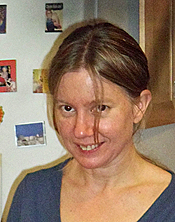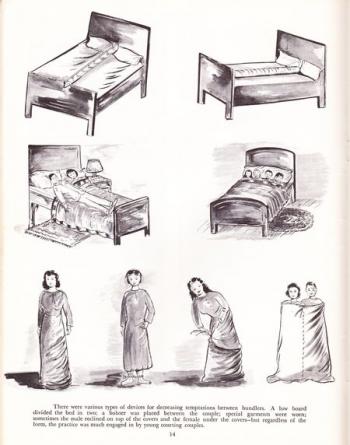The bliss of the bedroom: In praise of nests
![A nest is "...a house built by and for the body, taking its form from the inside, like a shell, in an intimacy that works physically. The form of the nest is commanded by the inside. 'On the inside...the instrument that prescribes a circular form for the nest is nothing else but the body of the bird. It is by constantly turning round and round and pressing back the walls on every side, that it succeeds in forming this circle.' By exercising an active pressure, the female makes this into a felt-like padding." [The Poetics of Space by Gaston Bachelard c.1958] (Illustration by Rosie Curtis)](/sites/default/files/2014/01/field/image/Nest-by-Rosie.png)
A nest is "...a house built by and for the body, taking its form from the inside, like a shell, in an intimacy that works physically. The form of the nest is commanded by the inside. 'On the inside...the instrument that prescribes a circular form for the nest is nothing else but the body of the bird. It is by constantly turning round and round and pressing back the walls on every side, that it succeeds in forming this circle.' By exercising an active pressure, the female makes this into a felt-like padding." [The Poetics of Space by Gaston Bachelard c.1958]
Since our earliest evolution our sleeping spaces have always been places of refuge. The first division of space in a home is between the sleeping and living spaces, or private and public domains. Four-poster beds were an early way of creating a refuge within a larger space, a refuge that provided both privacy and warmth. The beds were so valuable that they were often built with lock and key mechanisms to stop them being dismantled and stolen during the day.
Finding a way to stay warm in a cold bedroom was always a challenge in a cold climate. The practice of "bundling" consisted of allowing a visitor to share a bed with a family member. The bundling board in the center of the bed acted as a rustic chastity belt to keep ones teenage daughter and the tall dark handsome stranger suitably separated.
As houses became easier to heat, previously cold bedrooms became places for things other than sleeping. From an Austin Powers style shagalicious love nest to a brooding teenager's messy den, our rooms have become places to figure out who we are. Just as a bird's nest is a physical reflection of its very form, our bedrooms can and do reflect our most intimate selves.
In many western homes the bedroom has evolved from a space within a space to a bedroom suite. It is often in its own wing and includes a bathroom with separate bath and shower, two walk-in closets (hers is twice the size of his), a sitting area, personal work space, laundry room -- and of course a cathedral ceiling and killer views. This is separated from the house by a hallway and a couple of doors. While retreating to such a comprehensive suite of spaces may fill our physical needs for sleep and clothes storage, how does it fill our psychological need for the safety, security and dreaming that the image of a birds nest provides.
Palatial-size bedrooms are not intimate spaces. Cathedral ceilings and walls of glass take us outside of ourselves rather than encouraging us to retreat and are more appropriate for living rooms. Smaller spaces with lower ceilings are often more conducive to intimacy and rest. Pockets of smaller spaces in a large room can be created with a window seat or overstuffed armchair. Putting the bed in a low-ceilinged alcove can create a room within a room that speaks to us of nesting.
Perhaps how we feel when we walk into our bedroom is more important than its size or proportion. In feng shui, the bedroom is the most important room in the house because it is where we rejuvenate ourselves. If every time we walk through the bedroom door our heart sinks because we see piles of clutter to be sorted out or things to be fixed, it saps our energy on a subconscious level and negates the notion of refuge. The birds nest has only what is needed for safety, warmth and comfort.
Placement of the bed is considered a core element in creating a safe space. Ideally a bed should have a solid headboard with its back to a solid wall and a clear view of the door. In order to attract or maintain a relationship there should be identical bedside tables with matching lamps and space either side of the bed. Conversely, push your teenage daughter's bed up against the wall and provide just one bedside table.
The need to express ourselves individually is a modern development and our bedrooms are becoming spaces that hold us so that we can let go and express our most intimate private selves. We have an innate need for spaces that are just ours. That space can be as small as a shoebox that contains our treasured possessions or a room where the bed hangs from the ceiling and the walls are painted black. The emotive power of our personal spaces is attested to by how heart wrenching it is to paint over the graffiti and memories of our children's rooms when they fly the nest.
So we would like to speak in support of bedrooms, bedrooms that enable us to breathe a sigh of relief when we walk into them. Feathering our nests is more important than ever. Creating a sanctuary of serenity allows us to truly rejuvenate ourselves on a daily basis. Instead of a two-week cruise once a year, maybe it's better to wake up every morning in a space that you love.
More Design Notes:
• The utility of Maine style: From barrel staves to clapboards
• Design Notes: An introduction
• The Welcome Mat: The story of front and back
• Moments of Delight 1: Boynton–McKay Food Co.
• Is It Food Or Is It Art? Rockland's Main Street
• The domestication of the garage

Chris Wohler came to Camden 20 years ago after living in New York for 24 years. She has a Bachelor of Arts in history from Cornell University and a Master of Architecture from Columbia University. She has taught at Ball State University, Parsons School of Design and Columbia University. Her design practice, Breathing Space, encompasses everything from architectural design to retail merchandising.
She likes blackbirds, crosswords, babies, Miles Davis, avocados, quantum physics, Robert Frank, chartreuse, Puccini, roses, graphite drawings, the collaborative process, Great Danes, Patti Smith, gardening, J.S. Bach’s Suites for Solo Cello, architectural plans, movies, Philip Pullman, cooking with friends, everything by Beethoven, New York City and her two sons who currently live there. Reach her at breathingspace2@gmail.com.
Rosie Curtis lives in Camden and teaches architecture at UMA.

Originally from England, she has been designing and building in Midcoast Maine for the last 20 years, although she indulges in a spot of work for a British engineering firm now and then. She holds two bachelor’s degrees and a master’s degree in architecture and has been interested in the built environment her whole life. She believes that design is fundamentally about things working well and looking good. Her two kids are fed up of hearing her pontificate about all things design related and hope this column will provide a channel for her endless wonderings. Reach her at rosie@fairpoint.net.


























